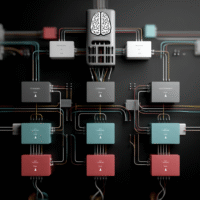AI News
-
QwenLong-L1: Reinforcement Learning Framework for Long-Context Reasoning in Large Language Models
Introducing QwenLong-L1: A New Approach to Long-Context Reasoning in AI Recent advancements in large reasoning models (LRMs) have shown remarkable success in short-context reasoning. However, these models struggle with long-context scenarios, which are essential for applications like multi-document question-answering (QA), research synthesis, and legal or financial analysis. These tasks often require processing sequences that exceed […] ➡️➡️➡️
-
Panda: A Foundation Model for Zero-Shot Forecasting in Nonlinear Dynamics
Panda: A New Approach to Forecasting Nonlinear Dynamics Panda: A New Approach to Forecasting Nonlinear Dynamics Researchers at the University of Texas at Austin have developed a groundbreaking model called Panda, designed to improve the forecasting of chaotic systems. This innovative model is trained on a vast dataset of 20,000 chaotic ordinary differential equations (ODEs) […] ➡️➡️➡️
-
Differentiable MCMC Layers: Revolutionizing Neural Networks for Combinatorial Optimization
Differentiable MCMC Layers: A New AI Framework for Discrete Decision-Making Understanding the Challenge Neural networks excel at processing complex data but struggle with discrete decision-making tasks, such as vehicle routing or scheduling. These tasks often involve strict constraints and are computationally intensive. Traditional methods for solving these combinatorial problems can be inefficient and do not […] ➡️➡️➡️
-
Dynamic Reward Reasoning Models Enhance LLM Judgment and Alignment
Enhancing Reasoning in Large Language Models Can Large Language Models Really Judge with Reasoning? Introduction Recent advancements in large language models (LLMs) have sparked interest in their reasoning and judgment capabilities. Researchers from Microsoft and Tsinghua University have developed Reward Reasoning Models (RRMs) to improve the alignment of LLMs by dynamically adjusting computational resources during […] ➡️➡️➡️
-
Creating Synthetic Data with the Synthetic Data Vault: A Step-by-Step Guide
Step-by-Step Guide to Creating Synthetic Data with the Synthetic Data Vault (SDV) In today’s data-driven world, real-world data often comes with challenges such as high costs, messiness, and strict privacy regulations. Synthetic data presents a viable solution, enabling businesses to train large language models, simulate fraud detection scenarios, and pre-train vision models without compromising privacy. […] ➡️➡️➡️
-
NVIDIA Launches Llama Nemotron Nano 4B: Efficient AI Model for Edge Computing
NVIDIA’s Llama Nemotron Nano 4B: A Game Changer for Edge AI NVIDIA’s Llama Nemotron Nano 4B: A Game Changer for Edge AI Introduction NVIDIA has introduced the Llama Nemotron Nano 4B, an innovative open-source reasoning model designed to excel in various scientific tasks, programming, symbolic mathematics, function calling, and instruction following. With just 4 billion […] ➡️➡️➡️
-
NVIDIA AceReason-Nemotron: Advancing Math and Code Reasoning with Reinforcement Learning
NVIDIA AI Introduces AceReason-Nemotron: Enhancing Math and Code Reasoning with Reinforcement Learning Introduction Reasoning is a critical component of advanced AI systems. The launch of OpenAI’s o1 sparked interest in developing reasoning models using large-scale reinforcement learning (RL). However, the initial release of DeepSeek-R1 lacked crucial technical details, such as data curation strategies and specific […] ➡️➡️➡️
-
Microsoft Launches NLWeb: Simplifying AI-Powered Natural Language Interfaces for Websites
Microsoft’s NLWeb: Enhancing AI-Powered Web Integration Microsoft’s NLWeb: Enhancing AI-Powered Web Integration Many websites face challenges in providing accessible and cost-effective solutions for integrating natural language interfaces. This limitation can hinder user interactions with site content through conversational AI. Traditional methods often rely on centralized services or require advanced technical skills, which can restrict scalability […] ➡️➡️➡️
-
Introducing GRIT: A New Method for Teaching MLLMs to Reason with Images and Text
GRIT: Enhancing MLLM Performance with Visual Reasoning GRIT: Enhancing MLLM Performance with Visual Reasoning Understanding the Challenge The development of Multimodal Large Language Models (MLLMs) aims to merge visual content understanding with language processing. However, many of these models face challenges when trying to reason effectively about images. Often, they can provide answers but fail […] ➡️➡️➡️
-
Build a Customizable Multi-Tool AI Agent with LangGraph and Claude
Building a Custom Multi-Tool AI Agent: A Practical Guide This guide provides a straightforward approach to creating a customizable multi-tool AI agent using LangGraph and Claude. Designed for a range of tasks such as mathematical calculations, web searches, weather inquiries, text analysis, and real-time information retrieval, this tutorial is accessible for beginners and experts alike. […] ➡️➡️➡️
-
Optimizing Assembly Code with LLMs: Reinforcement Learning Surpasses Traditional Compilers
Optimizing Assembly Code with Large Language Models (LLMs) Introduction As the demand for efficient programming techniques grows, the optimization of assembly code has emerged as a key area of focus. Traditional compilers have long been the go-to solution for this task. However, recent innovations in artificial intelligence, particularly through the use of Large Language Models […] ➡️➡️➡️
-
Advanced Round-Robin Multi-Agent Workflows with Microsoft AutoGen
Advanced Multi-Agent Workflows with Microsoft AutoGen A Comprehensive Guide to Advanced Multi-Agent Workflows with Microsoft AutoGen Introduction This guide explores how Microsoft’s AutoGen framework enables developers to create sophisticated multi-agent workflows with ease. By utilizing AutoGen’s features, you can integrate various specialized assistants, such as Researchers, FactCheckers, Critics, Summarizers, and Editors, into a unified tool […] ➡️➡️➡️
-
Group Think: Enhancing Collaborative LLM Inference with Token-Level Multi-Agent Reasoning
Enhancing Business Efficiency with Group Think: A New Approach to AI Collaboration Introduction to Group Think In the rapidly evolving field of artificial intelligence, the ability for large language models (LLMs) to work together is gaining significant attention. The concept of Group Think introduces a multi-agent reasoning paradigm that allows these models to collaborate effectively, […] ➡️➡️➡️
-
Evaluating AI Assistants for Complex Voice-Driven Workflows in Enterprises
Evaluating Enterprise-Grade AI Assistants Evaluating Enterprise-Grade AI Assistants: A Benchmark for Complex, Voice-Driven Workflows Introduction As businesses increasingly adopt AI assistants, it’s crucial to evaluate their effectiveness in real-world tasks, particularly through voice interactions. Traditional evaluation methods often overlook the complexities of specialized workflows, highlighting the need for a more comprehensive framework that accurately assesses […] ➡️➡️➡️
-
Thinkless: Innovative Framework Reduces Language Model Reasoning by 90%
Thinkless: Enhancing Language Model Efficiency Introducing Thinkless: A New Framework for Language Models Researchers at the National University of Singapore have developed a groundbreaking framework called Thinkless. This innovative solution focuses on improving the efficiency of language models by reducing unnecessary reasoning by as much as 90%. Current language models often engage in complex reasoning […] ➡️➡️➡️
-
MMLONGBENCH: A New Benchmark for Long-Context Vision-Language Models
MMLONGBENCH: A New Benchmark for Long-Context Vision-Language Models MMLONGBENCH: A New Benchmark for Long-Context Vision-Language Models Understanding Long-Context Vision-Language Models Recent advancements in long-context modeling have greatly improved the performance of large language models (LLMs) and large vision-language models (LVLMs). These long-context vision-language models (LCVLMs) can now process extensive amounts of data, including hundreds of […] ➡️➡️➡️
-
Microsoft AI Launches Magentic-UI: Collaborative Open-Source Agent for Enhanced Web Task Automation
Microsoft AI’s Magentic-UI: A Collaborative Approach to AI Agents Microsoft AI’s Magentic-UI: A Collaborative Approach to AI Agents Introduction The modern web has transformed how we interact with digital platforms. Activities such as filling out forms, managing accounts, and navigating dashboards often require repetitive manual input. While AI has emerged to automate some of these […] ➡️➡️➡️
-
Enhancing Reasoning in Large Language Models: A Structured Approach
Enhancing Reasoning in AI Models for Business Applications Enhancing Reasoning in AI Models for Business Applications Understanding Large Reasoning Models Large Reasoning Models (LRMs), such as OpenAI’s o1 and o3, DeepSeek-R1, Grok 3.5, and Gemini 2.5 Pro, showcase impressive capabilities in complex reasoning tasks. These models often exhibit behaviors like self-correction and backtracking, which can […] ➡️➡️➡️
-
Anthropic Launches Claude Opus 4 and Sonnet 4: Advances in AI Reasoning and Coding
Anthropic’s Claude Opus 4 and Claude Sonnet 4: Advancements in AI for Business Introduction to Claude Models Anthropic has launched its latest language models, Claude Opus 4 and Claude Sonnet 4. These models represent a significant step forward in artificial intelligence, particularly in areas like reasoning, coding, and the design of autonomous agents. Businesses can […] ➡️➡️➡️
-
Falcon-H1: TII’s Hybrid Language Models for Scalable Multilingual Understanding
Transforming Business with Falcon-H1: A New Era in Language Models Overview of Falcon-H1 The Technology Innovation Institute (TII) has launched the Falcon-H1 series, representing a significant advancement in language model technology. These models combine the strengths of Transformer networks and Structured State Space Models (SSMs) to create a hybrid architecture that enhances efficiency and performance […] ➡️➡️➡️
















